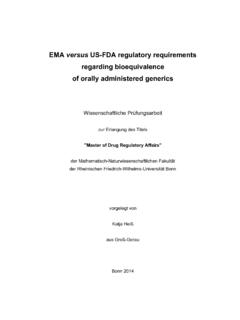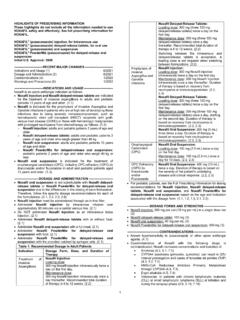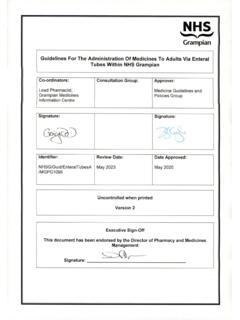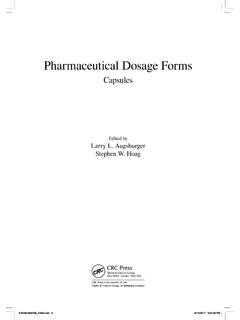Transcription of Pharmacy Pharmaceutical Technology Tablets
1 Pharmacy Pharmaceutical Technology Tablets Dr Sahoo Asstt. Professor Delhi Institute of Pharmaceutical Sciences and Research Pusph Vihar-III, , New Delhi-110017 (04-10-2007) CONTENTS IntroductionDifferent types of tabletsTablet ingredientsGranulation Technology Types of granulators Granulation characteristicsTabletting technologyEvaluation of tabletTablet coating Types of coating Compression coating machines 1 Introduction Solid medicaments may be administered orally as powders, pills, cachets, capsules or Tablets .These dosage forms contain a quantity of drug which is given as a single unit and they are known collectively as solid unit dosage forms, even in the case of sustained action preparations which, technically, contain the equivalent of several normal doses of drug.
2 The stringent formulation requirements of modern medicaments, the many advantages of tablet and capsule medication, coupled with expanding health services and the commitment need for large-scale economic manufacture, have led to a steady decline in the prescribing of powders and pills . Tablets and capsules, on the other hand, currently account for well over two third of the total number and cost of medicines produced all over the world. Tablet is defined as a compressed solid dosage form containing medicaments with or without excipients.
3 According to the Indian Pharmacopoeia Pharmaceutical Tablets are solid, flat or biconvex dishes, unit dosage form, prepared by compressing a drugs or a mixture of drugs, with or without diluents. They vary in shape and differ greatly in size and weight, depending on amount of medicinal substances and the intended mode of administration. It is the most popular dosage form and 70% of the total medicines are dispensed in the form of Tablet. All medicaments are available in the Tablet form except where it is difficult to formulate or administer.
4 The advantages of the Tablet dosage form are: 1. They are unit dosage form and offer the greatest capabilities of all oral dosage form for the greatest dose precision and the least content variability. 2. Cost is lowest of all oral dosage form. 3. Lighter and compact. 4. Easiest and cheapest to package and strip. 5. Easy to swallowing with least tendency for hang-up. 6. Sustained release product is possible by enteric coating. 7. Objectionable odour and bitter taste can be masked by coating technique. 8. Suitable for large scale production.
5 9. Greatest chemical and microbial stability over all oral dosage form. 10. Product identification is easy and rapid requiring no additional steps when employing an embossed and/or monogrammed punch face. Disadvantages of Tablet dosage form are: 1. Difficult to swallow in case of children and unconscious patients. 2. Some drugs resist compression into dense compacts, owing to amorphous nature, low density character. 3. Drugs with poor wetting, slow dissolution properties, optimum absorption high in GIT may be difficult to formulate or manufacture as a tablet that will still provide adequate or full drug bioavailability.
6 4. Bitter testing drugs, drugs with an objectionable odor or drugs that are sensitive to oxygen may require encapsulation or coating. In such cases, capsule may offer the best and lowest cost. 2 General properties of Tablet dosage forms: 1. A tablet should have elegant product identity while free of defects like chips, cracks, discoloration, and contamination. 2. Should have sufficient strength to withstand mechanical shock during its production packaging, shipping and dispensing. 3. Should have the chemical and physical stability to maintain its physical attributes over time 4.
7 The tablet must be able to release the medicinal agents in a predictable and reproducible manner. 5. Must have a chemical stability over time so as not to follow alteration of the medicinal agents. Different types of Tablets (A) Tablets ingested orally: 1. Compressed tablet, Paracetamol tablet 2. Multiple compressed tablet 3. Repeat action tablet 4. Delayed release tablet, Enteric coated Bisacodyl tablet 5. Sugar coated tablet, Multivitamin tablet 6. Film coated tablet, Metronidazole tablet 7. Chewable tablet, Antacid tablet (B) Tablets used in oral cavity: 1.
8 Buccal tablet, Vitamin-c tablet 2. Sublingual tablet, Vicks Menthol tablet 3. Troches or lozenges 4. Dental cone (c) Tablets administered by other route: 1. Implantation tablet 2. Vaginal tablet, Clotrimazole tablet (D) Tablets used to prepare solution: 1. Effervescent tablet, Dispirin tablet (Aspirin) 2. Dispensing tablet, Enzyme tablet (Digiplex) 3. Hypodermic tablet 4. Tablet triturates Enzyme tablet (Digiplex) Compressed Tablets : Standard uncoated Tablets are manufactured by compression. The general methods are by wet granulation, dry granulation or direct compression, used for rapid disintegration and drug release.
9 Both type of action systemic effect and local effect. Multiple compressed Tablets : For incompatible components these are: A) Layered tablet- either two layered (for two components) or three layered (for three components) tablet. B) Compressed coated type- either tablet within a tablet or tablet within a tablet within a tablet. Tablet in this category are usually prepared for two reasons 1. To separate physically or chemically incompatible ingredients. 2. To produce repeat action or prolong action product. 3 Repeat action tablet: Sugar coated or multiple compressed Tablets are used for this purpose.
10 The core tablet is usually coated with shellac or an enteric polymer so that it will not release its drug in stomach but intestine. Delayed action and enteric-coated tablet: This dosage form is intended to release the drug after some time delay or after the tablet has passed one part of the GIT into another. All enteric coated Tablets are type of delayed action tablet but all delayed action Tablets are not enteric or not intended to produce enteric action. Sugar coated tablet: Primary role is to produce an elegant, glossy, easy to swallow, widely utilized in preparing multivitamin and multivitamin mineral combination.






